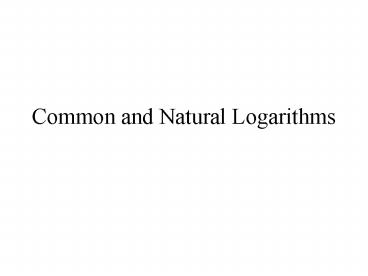Common and Natural Logarithms PowerPoint PPT Presentation
Title: Common and Natural Logarithms
1
Common and Natural Logarithms
2
Common Logarithms
- A common logarithm has a base of 10.
- If there is no base given explicitly, it is
common. - You can easily find common logs of powers of ten.
- You can use your calculator to evaluate common
logs.
3
Natural Logarithms
- A natural logarithm has a base of e.
4
- The mathematical constant e is the unique real
number such that the value of the derivative (the
slope of the tangent line) of the function f(x)
ex at the point x 0 is exactly 1. - The function ex so defined is called the
exponential function. - The inverse of the exponential function is the
natural logarithm, or logarithm with base e. - The number e is also commonly defined as the base
of the natural logarithm (using an integral to
define the latter), as the limit of a certain
sequence, or as the sum of a certain series. - The number e is one of the most important numbers
in mathematics, alongside the additive and
multiplicative identities 0 and 1, the constant
p, and the imaginary number i. - e is irrational, and as such its value cannot be
given exactly as a finite or eventually repeating
decimal. The numerical value of e truncated to 20
decimal places is - 2.71828 18284 59045 23536..
5
Natural Logarithms
- A natural logarithm has a base of e.
- We write natural logarithms as ln.
- In other words, loge x ln x.
- If ln e x
6
Change of Base Formula
- Allows us to convert to a different base.
- If a, b, and n are positive numbers and neither a
nor b is 1, then the following equation is true.
7
- Examples of evaluating expressions
- Change of base formula examples
8
(No Transcript)
9
(No Transcript)
10
(No Transcript)
11
(No Transcript)
PowerShow.com is a leading presentation sharing website. It has millions of presentations already uploaded and available with 1,000s more being uploaded by its users every day. Whatever your area of interest, here you’ll be able to find and view presentations you’ll love and possibly download. And, best of all, it is completely free and easy to use.
You might even have a presentation you’d like to share with others. If so, just upload it to PowerShow.com. We’ll convert it to an HTML5 slideshow that includes all the media types you’ve already added: audio, video, music, pictures, animations and transition effects. Then you can share it with your target audience as well as PowerShow.com’s millions of monthly visitors. And, again, it’s all free.
About the Developers
PowerShow.com is brought to you by CrystalGraphics, the award-winning developer and market-leading publisher of rich-media enhancement products for presentations. Our product offerings include millions of PowerPoint templates, diagrams, animated 3D characters and more.

